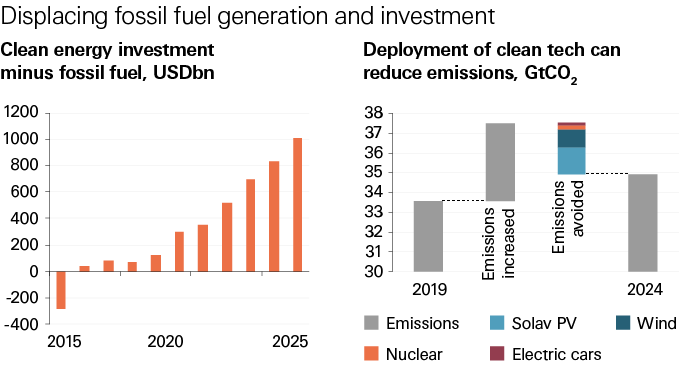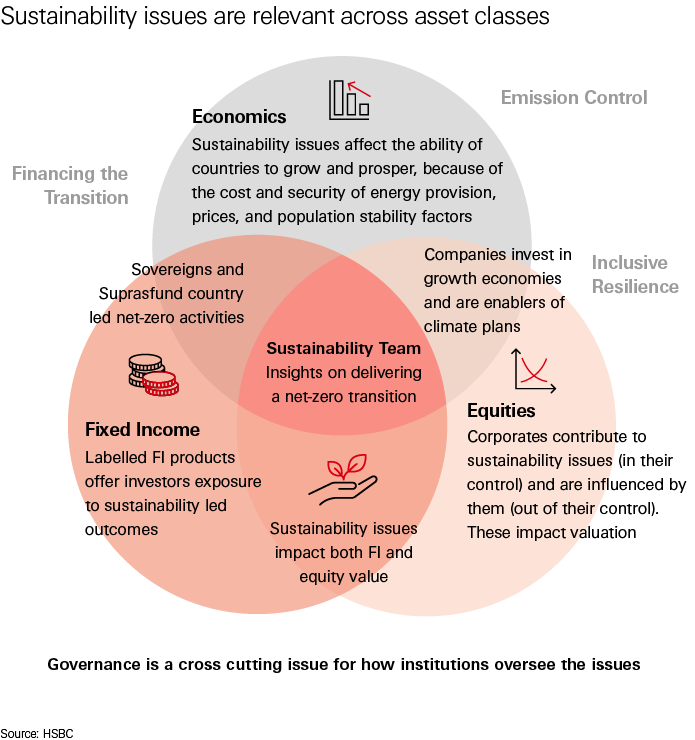- Article

- Global Research
- Energy transition
- Understand ESG
Net-Zero Navigator: Where will the money come from?
- The ability to finance the net-zero transition determines the speed and timing at which CO2 levels will stabilise
- This has a knock-on effect on temperature levels and the resulting physical impacts, such as productivity losses from heat stress
- Historically, financing has been a bottleneck; solving this means looking at unconventional funding sources and innovative products
Show me the money
Transitioning to a net-zero economy requires substantial investment.
The range of estimates varies between USD3.5trn and USD7.3trn per annum, depending on the scope and definition of green. In 2024, BNEF estimates investment of cUSD2.1trn1, equivalent to circa 2% of global total GDP in 20242.
So far, debt has been the major financial instrument used to transparently channel climate finance to fund climate actions. In 2024, over 65% of newly raised funding for energy transition and climate tech came from debt financing3.
Average annual investment estimates
Considering the big investment gap and short-term macroeconomic outlook, the current landscape of climate finance or clean energy investment provision is manifestly insufficient to support the net-zero transition. Financing will have to be found from different sources, including from some unconventional places, such as national oil companies (NOC). This is controversial as they are often perceived as the biggest obstacle to economy-wide decarbonisation. But pragmatically – taking into account political will, domestic priorities and energy security concerns, and the fact that energy transition will not happen overnight – it makes sense to look at how cash from oil and gas can be deployed effectively for transition. These revenue-rich businesses can provide stable and substantial cash flows to governments and SWFs, which can spend the dividend received from the NOC on supporting domestic and foreign energy transition, and diversifying their portfolio and risks.
Funding is vital not only to drive efforts to reduce emissions, but also to achieve inclusive resilience. Adaptation finance supports the ability to manage climate-related environmental risks at the same time as protecting people, communities and economies. This in turn safeguards investments, enables inclusive growth, reduces systemic risk and supports productivity.
However, the global adaptation financing gap is significant, with international public financing flows at USD28bn in 2022, compared to an estimated need of up to USD359bn annually (according to the UNEP Adaptation Gap report 2024). What’s more, at a national level, efforts to reduce emissions through nationally determined contributions (NDCs) often fail to join up fully with national adaptation plans (NAPs), with just 16% defined as fully aligned. However, we believe there is an opportunity for the currently underutilised private sector to play a greater role here. Investment in carbon sinks and nature-based solutions, for example, have the potential not only to contribute towards climate targets, but also to build resilience to physical climate risks and drive the net-zero transition.
Our Sustainability Approach
Sustainability research is entering a new phase, with the transmission mechanism of issues affecting value creation into financial decision making at its core. We think that delivering a net-zero transition is the most material sustainability issue with the highest likelihood of disrupting growth and asset value potential, both positively and negatively. We expect the economics of driving net-zero outcomes to take centre stage over policy momentum.
New questions and new answers
Growing and protecting wealth for the future is central to investor mandates. To deliver this, investors must make good decisions about the value creation potential of the asset classes they invest in. We argue that sustainability research is intrinsic to value creation because it focuses on the issues driving prosperous outcomes that enable people to thrive. If people do not thrive, social stability is threatened, and economic activity is unlikely to reach full potential, in turn affecting growth expectations and the political economy. As expectations around economic growth and productivity fluctuate, so does the market value of financial instruments. But sustainability research is at a crossroads, which means it’s time for a reinvention. What will this look like? We expect investors to focus on the transmission mechanism of value creation and disruption from sustainability factors across asset classes, with three shifts in analytical thinking taking place.
Would you like to know more? Click here to read the full report. Please note, you must be a subscriber to HSBC Global Investment Research to access this link.
To find out more, including how to subscribe, please email us at AskResearch@hsbc.com
- Bloomberg New Energy Finance (BNEF), Energy Transition Investment Trends 2025, 30 January 2025
- IMF, World Economic Outlook, April 2025
- BNEF (2025), Energy Transition Investment Trend 2025
- BNEF, Global Investment in the Energy Transition Exceeded $2 Trillion for the First Time in 2024, According to BloombergNEF Report, 30 January 2025
- Independent High-Level Expert Group on Climate Finance (IHEGCF), Raising ambition and accelerating delivery of climate finance, November 2024
- OECD, Massive investment is needed in sustainable infrastructure to build climate change resilience, 9 April 2024
- Energy Transition Commission, How to Make the Money Flow for a net-zero economy, March 2023
- Climate Policy Initiative, How big is the Net net-zero financing gap?, September 2023
The following analyst(s), who is(are) primarily responsible for this document, certifies(y) that the opinion(s), views or forecasts expressed herein accurately reflect their personal view(s) and that no part of their compensation was, is or will be directly or indirectly related to the specific recommendation(s) or views contained in this research report: Zoe Knight
This document has been issued by the Research Department of HSBC.
HSBC and its affiliates will from time to time sell to and buy from customers the securities/instruments, both equity and debt (including derivatives) of companies covered in HSBC Research on a principal or agency basis or act as a market maker or liquidity provider in the securities/instruments mentioned in this report.
Analysts, economists, and strategists are paid in part by reference to the profitability of HSBC which includes investment banking, sales & trading, and principal trading revenues.
Whether, or in what time frame, an update of this analysis will be published is not determined in advance.
For disclosures in respect of any company mentioned in this report, please see the most recently published report on that company available at www.hsbcnet.com/research.
Additional disclosures
- This report is dated as at 16 June 2025.
- All market data included in this report are dated as at close 11 June 2025, unless a different date and/or a specific time of day is indicated in the report.
- HSBC has procedures in place to identify and manage any potential conflicts of interest that arise in connection with its Research business. HSBC's analysts and its other staff who are involved in the preparation and dissemination of Research operate and have a management reporting line independent of HSBC's Investment Banking business. Information Barrier procedures are in place between the Investment Banking, Principal Trading, and Research businesses to ensure that any confidential and/or price sensitive information is handled in an appropriate manner.
- You are not permitted to use, for reference, any data in this document for the purpose of (i) determining the interest payable, or other sums due, under loan agreements or under other financial contracts or instruments, (ii) determining the price at which a financial instrument may be bought or sold or traded or redeemed, or the value of a financial instrument, and/or (iii) measuring the performance of a financial instrument or of an investment fund.
This document has been issued by HSBC Bank Middle East Ltd, DIFC, which has based this document on information obtained from sources it believes to be reliable but which it has not independently verified. Neither HSBC Bank Middle East Ltd, DIFC nor any member of its group companies (“HSBC”) make any guarantee, representation or warranty nor accept any responsibility or liability as to the accuracy or completeness of this document and is not responsible for errors of transmission of factual or analytical data, nor is HSBC liable for damages arising out of any person’s reliance on this information. The information and opinions contained within the report are based upon publicly available information at the time of publication, represent the present judgment of HSBC and are subject to change without notice.
This document is not and should not be construed as an offer to sell or solicitation of an offer to purchase or subscribe for any investment or other investment products mentioned in it and/or to participate in any trading strategy. It does not constitute a prospectus or other offering document. Information in this document is general and should not be construed as personal advice, given it has been prepared without taking account of the objectives, financial situation or needs of any particular investor. Accordingly, investors should, before acting on it, consider the appropriateness of the information, having regard to their objectives, financial situation and needs. If necessary, seek professional investment and tax advice.
The decision and responsibility on whether or not to purchase, subscribe or sell (as applicable) must be taken by the investor. In no event will any member of the HSBC group be liable to the recipient for any direct or indirect or any other damages of any kind arising from or in connection with reliance on any information and materials herein.
Past performance is not necessarily a guide to future performance. The value of any investment or income may go down as well as up and you may not get back the full amount invested. Where an investment is denominated in a currency other than the local currency of the recipient of the research report, changes in the exchange rates may have an adverse effect on the value, price or income of that investment. In case of investments for which there is no recognised market it may be difficult for investors to sell their investments or to obtain reliable information about its value or the extent of the risk to which it is exposed. Some of the statements contained in this document may be considered forward looking statements which provide current expectations or forecasts of future events. Such forward looking statements are not guarantees of future performance or events and involve risks and uncertainties. Actual results may differ materially from those described in such forward-looking statements as a result of various factors.
This document is for information purposes only and may not be redistributed or passed on, directly or indirectly, to any other person, in whole or in part, for any purpose. The distribution of this document in other jurisdictions may be restricted by law, and persons into whose possession this document comes should inform themselves about, and observe, any such restrictions. By accepting this report, you agree to be bound by the foregoing instructions. If this report is received by a customer of an affiliate of HSBC, its provision to the recipient is subject to the terms of business in place between the recipient and such affiliate. The document is intended to be distributed in its entirety. Unless governing law permits otherwise, you must contact a HSBC Group member in your home jurisdiction if you wish to use HSBC Group services in effecting a transaction in any investment mentioned in this document.
Certain investment products mentioned in this document may not be eligible for sale in some states or countries, and they may not be suitable for all types of investors. Investors should consult with their HSBC representative regarding the suitability of the investment products mentioned in this document.
HSBC and/or its officers, directors and employees may have positions in any securities in companies mentioned in this document. HSBC may act as market maker or may have assumed an underwriting commitment in the securities of companies discussed in this document (or in related investments), may sell or buy securities and may also perform or seek to perform investment banking or underwriting services for or relating to those companies and may also be represented on the supervisory board or any other committee of those companies.
From time to time research analysts conduct site visits of covered issuers. HSBC policies prohibit research analysts from accepting payment or reimbursement for travel expenses from the issuer for such visits.
HSBC Bank Middle East Ltd (“HBME”) is incorporated in the Dubai International Financial Centre, regulated by the Central Bank of the U.A.E and the Securities and Commodities Authority-License No. 602004, and lead regulated by the Dubai Financial Services Authority. Within UAE, HBME issues Research via HSBC Bank Middle East Limited, DIFC, located within the Dubai International Financial Centre and regulated by the Dubai Financial Services Authority, as well as through HSBC Bank Middle East Limited UAE branch, regulated by the Securities and Commodities Authority under License No. 602004 (Fifth Category) for Financial Consultation and Financial Analysis.
© Copyright 2025, HSBC Bank Middle East Ltd, DIFC ALL RIGHTS RESERVED. No part of this publication may be reproduced, stored in a retrieval system, or transmitted, on any form or by any means, electronic, mechanical, photocopying, recording, or otherwise, without the prior written permission of insert issuing entity name.
Issuer of report
HSBC Bank Middle East Ltd, DIFC
People power: Enabling the net-zero shift
People are at the heart of the net-zero transition.






